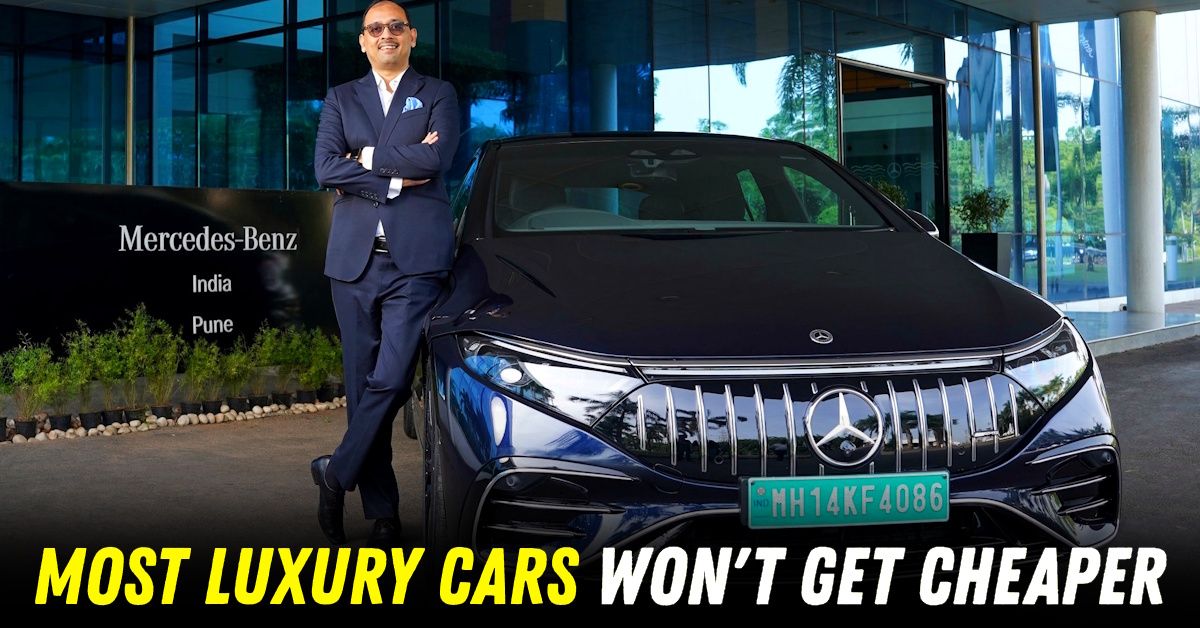India-UK Free Trade Agreement Will Not Make Luxury Cars Cheaper: Mercedes Benz Top Official


The recently signed India-UK Free Trade Agreement (FTA) has triggered a wave of discussion around its possible implications for the luxury car segment. While British brands such as Jaguar Land Rover (JLR) are expected to benefit from reduced import duties, Mercedes-Benz India believes the agreement is unlikely to significantly alter the industry’s dynamics. The company points to its local production strategy as a key reason for this outlook, though the implications may differ for manufacturers dependent on fully built imports.
Mercedes-Benz India has built a strong presence through local assembly. With around 95 percent of its domestic sales comprising locally assembled vehicles, the brand attracts just 15 percent customs duty on these models.
Since the FTA does not fully waive duties and applies a quota-based structure, the company anticipates minimal disruption to its pricing or operations. Best-selling models like the C-Class and E-Class are assembled in Pune using completely knocked-down (CKD) kits, which insulates them from sharp import duty changes. Even high-end imports such as the Maybach S 680 account for only a small portion of total sales.
This localisation-first approach is common across the industry. Around 80 percent of luxury vehicles sold in India are assembled locally, reducing exposure to import-linked cost volatility. Other global players like BMW and Audi follow similar models, further limiting the ripple effect of the FTA.
The agreement does offer moderate tariff reductions on CKD units, with effective duties expected to drop from 16.5 percent to 11.5 percent. But this is unlikely to trigger aggressive price cuts, as most luxury brands have already absorbed input cost fluctuations through local manufacturing.
The clearest impact may be seen in the ultra-luxury space, where brands reliant on fully imported vehicles may lower prices to attract new buyers. However, such moves are expected to influence only a small section of the market.
One of the more strategic outcomes of the FTA lies in its treatment of electric and hybrid vehicles. UK-made EVs will enjoy improved access to the Indian market under the new framework. At the same time, Indian-made EVs will gain a foothold in the UK.
This complements Mercedes’ ongoing investment in electrification, with models such as the EQS SUV already being assembled locally. While this supports the brand’s EV ambitions, it also reinforces the role of domestic production in its broader strategy.
Yet, challenges such as input cost pressures continue to loom. Mercedes recently implemented a 3 percent price hike to counter rising operational expenses. Broader market trends also remain flat, with luxury car volumes holding steady around 50,000 units annually. These underlying factors suggest that the FTA, while important on paper, may not have a transformative short-term effect.
Despite offering fresh avenues for UK-based brands, the FTA’s real-world impact on the Indian luxury segment may remain limited. Local production has become a cost-efficient, operationally secure model for most carmakers.
For high-value, low-volume imports, the agreement may help reduce pricing barriers. But for mainstream luxury vehicles, the cost advantages of assembling cars in India continue to outweigh the incentives of importing them at reduced duty rates.
Mercedes’ measured response reflects a broader industry sentiment. In a market where cost-efficiency, localisation, and long-term infrastructure investments dominate decision-making, a trade agreement alone cannot drive radical change. The FTA adds flexibility, but not necessarily urgency.
A major hypothetical hangs in the background: could manufacturers abandon local assembly in favour of importing vehicles under the FTA? The answer is not straightforward.
The agreement introduces a quota system. Vehicles falling within this quota can be imported at a reduced duty of 10 percent. But once brands exceed these limits, the regular phased duty reduction applies, stretching over a 10- to 15-year horizon.
For volume models like the Range Rover Evoque or Mercedes C-Class, quota limits would be exhausted quickly, leaving higher tariffs in place. That makes CKD assembly, which now attracts 11.5 percent duty, a more sustainable route.
On the other hand, niche vehicles like the Bentley Continental GT or Rolls-Royce Cullinan, which sell in small numbers, can remain profitable as fully built imports. These brands may skip local assembly altogether and benefit from sharper pricing without building infrastructure in India. Jaguar Land Rover may consider importing flagship models while retaining CKD operations for models with broader appeal.
Local assembly still has clear benefits. It avoids import-related delays, reduces logistics costs, and allows carmakers to better cater to Indian road conditions and buyer preferences. Moreover, India’s focus on domestic EV production adds another layer of incentive to stay invested locally. Even with lower import duties under the FTA, CKD operations offer a 5–8 percent cost advantage for most brands.
For British marques, the FTA opens the door to strategic experimentation. Brands can test demand for exclusive models, price them more competitively, or add niche variants to their Indian portfolio. But a wholesale retreat from local manufacturing is unlikely. The agreement creates options, not imperatives.
Ultimately, the FTA’s impact will be incremental. It provides more room to maneuver but doesn’t alter the rules of the game. Brands like Mercedes are likely to continue focusing on localisation, balancing flexibility with operational realism.